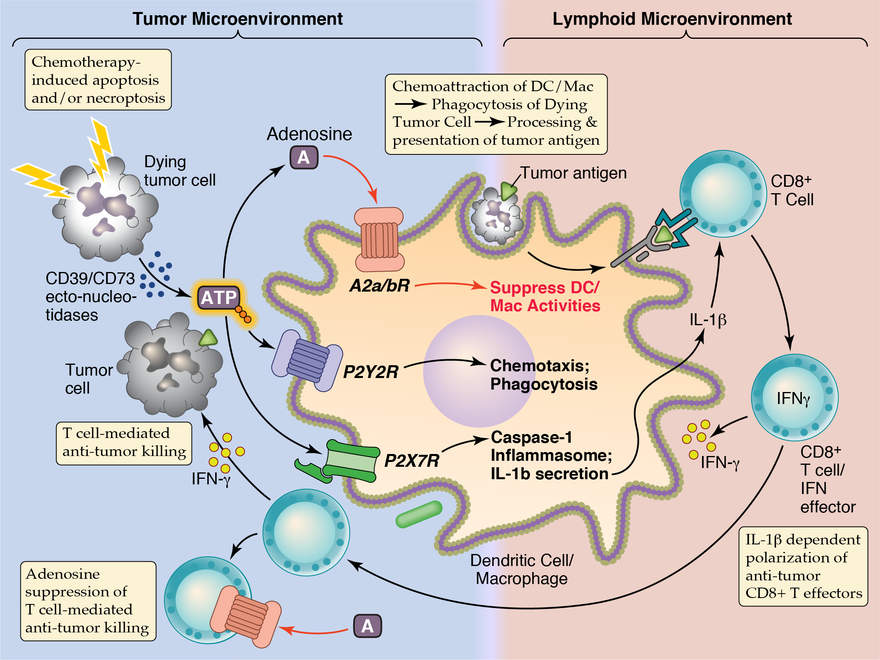
Signal transduction by extracellular nucleotides and inflammasomes in innate immunity and inflammation
The ability of cells to sense local tissue damage or microbial invasion is critical to the proper regulation of inflammatory and innate immune responses in health and disease. Such biological stresses often induce the release of ATP and other nucleotides from intact or damaged cells. The released nucleotides stimulate P2 receptors on nearby cells to rapidly induce adaptive responses such as vasodilation, hemostasis, and inflammation. Released nucleotides belong to the larger group of so-called DAMPs (Danger-Associated Molecular Patterns) that include other host-derived molecules (e.g., some nuclear proteins, nucleic acids, and metabolites like uric acid) which entrain innate immune and inflammatory responses. A common theme of current studies is the interaction between P2 nucleotide signaling and inflammasome signaling. Inflammasomes are signaling platforms that recruit various adapter proteins which nucleate the oligomerization and activation of proinflammatory members of the caspase-family proteases. We study several proinflammatory signaling responses triggered by extracellular ATP and other DAMPs, predominantly in murine models including mice with genetic deletion of various P2 receptors and inflammasome proteins.
Post-transcriptional and ionic signals that regulate assembly of inflammasome signaling platforms for caspase-1 activation and IL-1beta secretion: A major focus is to define the mechanisms by which ATP-gated P2X7 receptor channels or other stimuli that perturb ionic homeostasis trigger the very rapid and efficient assembly of NLRP3 inflammasome signaling complexes. The latter mediate accumulation of active caspase-1, caspase-1 processing of IL-1beta, and the non-classical secretion of the mature IL-1beta from macrophages, dendritic cells, and neutrophils.
Inflammasome-mediated pathways for non-classical secretion of IL-1beta and other inflammatory mediators: Unlike most inflammatory cytokines, IL-1beta lacks a signal sequence for targeting to the canonical ER/Golgi based pathways for constitutive secretion. Our studies have linked non-classical IL-1beta secretion to inflammasome-regulated mobilization of exosomes and microvesicles as well as induction of pyroptotic death of macrophages and dendritic cells.
Mechanisms for extracellular accumulation of ATP and other nucleotides in inflammation and cancer: A parallel component of our focus on signaling by extracellular ATP has been characterization of the mechanisms by which ATP is exported into, and metabolized within, extracellular compartments. We use novel luciferase-based methods to track highly localized release and clearance of extracellular ATP in several cell models. Recent studies have focused on defining how plasma membrane pannexin-1 channels are regulated to function as a major conductive pathway for ATP efflux from apoptotic tumor cells and possibly in other modes of regulated cell death.
Regulated cell death signaling pathways during inflammation: Our studies of proinflammatory signaling and ATP release mechanisms have also directed additional research into how these responses are integrated with the various modes of regulated cell death that include apoptosis, necroptosis, and pyroptosis. Delineation of the molecular mechanisms by which caspase-1 triggers pyroptosis, an intrinsically proinflammatory mode of regulated lytic cell death, is currently a major area of investigation.

| Major Research Areas |
|---|
| Cell Death Mechanisms, Inflammasome Regulation, Inflammation & Innate Immunity, Ion Channels |
| Disciplines |
| Signal Transduction |
| Organ Systems |
| Cardiovascular System, Immune System |
| Diseases |
| Cancer, Inflammation, Vascular Calcification |
| Major Techniques |
| Cell Culture, Cellular and Molecular Biology, Ion Transport |